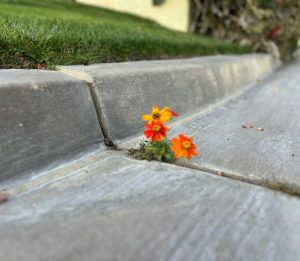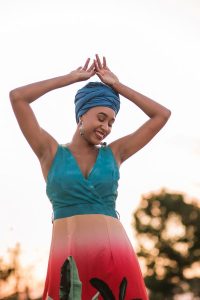by Nadia Ramoutar MMM Communications Coordinator Ireland 28.05.2025
 It is funny how sometimes we do something and have no idea the outcome our actions will have in future. I know that we don’t do something or take action sometimes because we are concerned about the unknown and feel fear. We sometimes don’t take action because we avoid venturing into the ambiguity of something new.
It is funny how sometimes we do something and have no idea the outcome our actions will have in future. I know that we don’t do something or take action sometimes because we are concerned about the unknown and feel fear. We sometimes don’t take action because we avoid venturing into the ambiguity of something new.
I am here to propose that we take on another perspective and realise that new actions can result in unexpected joy.
A few years ago, we were looking at ideas for our MMM Communication Department to raise money for the missions and to build more community. While going through old MMM Magazines, Sr Sheila and I read about the events that the Sisters used to host for these reasons. We were inspired to host a Christmas Craft Fair in Drogheda. There were a few people who thought it was a dreadful idea but they had the decency to tell us afterwards!
So, we had our Christmas Craft Fair and it was a big success. The hall was buzzing with activity, and it felt festive and fun. We invited the local children’s choir. They came and we loved having them here on the big stage in the auditorium. We also got to meet a lot of local crafters, artists and small business people who had stalls at the event.
Now, this year we got really brave (there are other words for it) and we added a Festival in May focused on Flowers, Food and Fun. Many of our Christmas vendors came and our lovely children’s choir. Speaking with the man in charge of the choir, Ken, he told me how much coming to the convent over the years has meant to the children in the choir. It is wonderful to have them here and witness them getting taller and more confident too.
This time, when the choirs’ sound equipment was being set up, I noticed something I had not realised before. The young man in charge of the sound is blind. He was busy getting things organised and ready, using a white stick. Honestly, I had been so preoccupied before, I had not noticed this. I stopped in my tracks and marvelled at his expertise with all the electronic equipment that made the children sound so great.
His blindness didn’t stop him from this important role. He was so agile and focused too that I had not realised he was blind. I really admire his talent and skill. It made me think how important it is not to be blind to our own bias or limited thinking. We think that we are trying to help other people – when in fact, they are helping us grow and see the world in a new, bigger way.
I reflect on the wonderful way in which God works and I am reminded of Proverbs 3:5.
“Trust in the LORD with all thine heart; and lean not unto thine own understanding.”
by Sr. Sheila Devane MMM Ireland 24.05.2025
 Scripture scholars are divided in their opinions as to whether Matthew, the tax collector, and Matthew, the evangelist, are one and the same person. In Tanzania we, MMMs, and a whole host of other members of the Christian faithful, especially the expatriate missionaries, were very devoted to Matthew, the tax collector. He was invoked on a regular basis and in all sorts of special emergency situations. Let me tell you about the origin and manner of our earnest prayers to this good man.
Scripture scholars are divided in their opinions as to whether Matthew, the tax collector, and Matthew, the evangelist, are one and the same person. In Tanzania we, MMMs, and a whole host of other members of the Christian faithful, especially the expatriate missionaries, were very devoted to Matthew, the tax collector. He was invoked on a regular basis and in all sorts of special emergency situations. Let me tell you about the origin and manner of our earnest prayers to this good man.
Our one retreat centre for many years was in a scenic place high up in the slopes of Mt. Kilimanjaro and run by the Benedictine Sisters of St. Killian. The founding sisters were Austrian, so they spoke German, a Germanic version of English, some Swahili and a little of one of the Chagga dialects. Mother Hildegard was a force of nature, small, rotund, with boundless energy, huge charisma, a great love of the people and with masterful administrative skills. She usually talked in a mixture of two if not three languages in the same sentence and was a combination of spiritual directress, organic farmer, strategic manager, and feisty contemplative nun, known far and wide.
As non-Tanzanians we were all annual visitors to the immigration office locally, and sometimes as far as Dar es Salaam, to renew our visas, and indeed many of us had far more visits to revenue and immigration than we wished for, as we tried to import a whole variety of items big, middle, and small to enable our various ministries. It wasn’t always easy as it never is for anyone anywhere in the world with immigration officialdom.
This is where Mother Hildegard’s spiritual advice was at its very best: on hearing of any imminent immigration visits or taxation matters, she immediately, there and then, would invoke the assistance of St. Matthew while loudly talking of his career as a tax collector, his inner knowledge of the often-devious workings of such a job and deeply believing that prayer could penetrate the hardest-hearted immigration officer. Her prayer was more one of ordering and instructing rather than petitioning. But it worked – real life miracles! So, we prayed to St. Matthew and, as MMMs, we also held the trump card on many such visits by having had a relative of at least one member of the immigration staff in our hospitals at some time or other. All good!
In December one year a group of us arrived in Rombo for our annual retreat; it was the rainy season and the rains that year were heavy; the countryside was magnificent. Mother Hildegard was unusually in bed the day we arrived and fearing she was ill we enquired to be told she was resting after a particularly challenging, but ultimately successful, experience. Knowing her it could have been just about anything under the sun!
A pious, very old, European lay woman who worked in the colonial government had died and requested in her legal will to be buried in that convent. The Sisters, knowing her quite well, agreed to this and held a simple, religious funeral service. Back in headquarters in Dar es Salaam there was upset. She was, after all, a member of government, burials are important and there was a desire, indeed a command to Rombo that the body be exhumed and brought to the capital for burial. Can you imagine the prayers to St. Matthew and the commotion as senior members of the government set out on their safari up the mountain to the convent to retrieve the body?
Mother Hildegard and the sisters were very conflicted as the late Marguerite had requested a Catholic grave among them and now she was about to be hiked off to a secular cemetery in Dar. But St. Matthew was summoned to task: the rains returned in force, the roads up the mountain virtually disappeared and the combination of torrential rain, raging storms, mud -sliding and sheer terror forced the government re-burial team to call off their efforts halfway up the mountain and to return to Dar, leaving the dead woman in her private grave among the Sisters. They never went back for the body.
Every time I need a parking space, and whenever I go to fill out an official form, I pray to St. Matthew, and I often hear Mother Hildegard’s voice ringing in my ears. May they pray for us.
by Sr. Margaret Anne Meyer MMM USA 21.05.2025
 In 1975, Sr. Dolorosa and I went for a holiday in Turkana, Kenya. A gentleman farmer took us there in his plane. We stopped in Kipsaraman and spent the night with Sr. Kathleen Crowley. The priest, Father Michael Gannon, SPS asked me to stay longer as Kathleen was alone at the time. That was the last I ever saw of him because the next morning he and the medical assistant crossed a small stream which suddenly became a wild gushing river in which about 10 people drowned. They were on their way to play football at a neighboring Mission. We went up in the plane to try and look for Father Michael’s body, but it was never found. Everyone was heartbroken. It was a sad day, indeed!
In 1975, Sr. Dolorosa and I went for a holiday in Turkana, Kenya. A gentleman farmer took us there in his plane. We stopped in Kipsaraman and spent the night with Sr. Kathleen Crowley. The priest, Father Michael Gannon, SPS asked me to stay longer as Kathleen was alone at the time. That was the last I ever saw of him because the next morning he and the medical assistant crossed a small stream which suddenly became a wild gushing river in which about 10 people drowned. They were on their way to play football at a neighboring Mission. We went up in the plane to try and look for Father Michael’s body, but it was never found. Everyone was heartbroken. It was a sad day, indeed!
In 1977, the Bishop asked me to leave Uganda for six weeks. The US Congress had stopped the coffee trade, and he feared there would be retaliation on the Americans. I went to Kitale for Christmas and it felt like the flight into Egypt. loved working in Uganda, and it looked like I would have to leave. Sr. Peter Channel provided a marvelous Christmas dinner which we enjoyed with the St. Patrick’s Fathers. I also went to Nairobi and helped Sr. Briege Breslin prepare Sr. Andre Brow to take a PAN AM flight to NY. Sr. Andre was extremely ill at the time. We were lucky to get some small containers of yogurt for her to take on the plane.
After returning to Kitovu, the American Government asked me to leave. I did not want to go but we had a community meeting and every Sister present told me to listen to the Bishop and not worry him more. A priest had been put in prison for two days without food or water and then deported. He did not want that to happen to me.
I left mid Feb 1978 to go to Tanzania. Again, I spent some days in Nairobi trying to get into Tanzania by plane, by way of Ethiopia. The Kenyan border with Tanzania was closed which made travel by road impossible. Sr. Fergal was very good to me at that time. She bought my plane ticket and stayed with me in the Flora Hostel.
Father Leo Bourke, a Blessed Sacrament Father, and brother of Brother John, had been sent out of Uganda and was then working at a Mission in Kenya. He came to see me in the Flora Hostel and invited me to go out shopping with him and have a meal at a Chinese restaurant. He also took me to see the grave of Edel Quinn. It was the last time I saw him alive. He died in 1982 at KCMC from chloroquin resistant malaria. I attended his funeral at Mtu wa Mbu in Tanzania. I asked the bishop if I could put a piece of bark cloth in his casket. I put in the best piece I had in his casket. It is a Ugandan custom to be buried with bark cloth. I cried very much for him. He was only 55 and looked like an angel in the coffin. He had visited Mom once when she was teaching in Elmont, NY. Father Leo gave her a rosary which Mom used for many years. I took it after she died to have as a remembrance for them both. Now it is so used and broken it remains in a little bark cloth purse to be buried with me when I die.
When the war broke out in 1979, we used to listen to the BBC in Dareda to hear the progress. The Sisters wrote that during the bombings they would sleep altogether in the big storeroom off the guest bedroom. Rex, the dog would snuggle around Sr. Catherine Nakintu. Sr. Aengus Campion hid under the altar in the chapel. One day a shell went seven feet into the ground a few minutes after Sr. Brigid Keogh went through the garden to the hospital. It took me a long time to settle in Tanzania but when I journaled, it seemed I was spared all this because I could have trailed behind Sr. Brigid and have been hit by that shell. Who knows? I thank God for the twelve happy years that I spent in Masaka.
by Sr. Joanne Kelly MMM Ireland 17.05.2025
 There are times when I seek a place of real solitude, a quiet place to reflect and pray.
There are times when I seek a place of real solitude, a quiet place to reflect and pray.
In fine weather this is easy to find in our lovely garden amidst the God-given beauty of nature. In the cold dark days, I go to the Mother Mary room in our house. This is a beautiful room which portrays in script and pictures the story of Mother Mary Martin, the founding of the Medical Missionaries and the beginning of the hospital known as Our Lady of Lourdes.
I also have the privilege at times of showing visitors round this room – something I thoroughly enjoy doing. I never cease to be amazed at the courage, faith and perseverance that Mother Mary had. I knew her as a shy, frail-looking, gentle woman and with great charm.
For a few years before the Covid pandemic, the Knights of St. Columbanus in Drogheda organised a Pilgrim Walk which began in Our Lady of Lourdes Church, visited the seven churches of Drogheda, both sides of the River Boyne, and finished at St. Peter’s Church in West Street. It attracted many people from far and near. One year they asked to include, as an option, a visit to the Mother Mary Room. I was one of those there to show the visitors around. Some wanted a brief look and get on with their walk, some wanted to spend lots of time with the story and others were eager to tell their own story of Mother Mary.
An elderly couple came in, not too sure if they were able for the whole walk, but eager to visit the Room. They were fascinated to see the actual desk (with its ink stains) and chair which Mother Mary used when she organised and directed the congregation at home and abroad and the kneeler she kept before her little crib all year round, on which there is an indent of her right knee.
The lady remembered the evenings she had in our house when she was part of the Apostolic Work Society. The Society was a group of women who were real missionaries but were not in a position to go out and work in foreign lands. Originally formed in Belfast, Mother Mary established branches of the society in Dublin and Drogheda.
This lady told of the one evening each week when the women met to sew Mass vestments, church linens and anything needed for a new mission and liturgical services. They did knitting and other crafts to make items for the annual Sale of Work as fund raising for the missions. It was a real social gathering, with plenty of chat and sharing – their weekly evening out. Her husband listened to all of this and remembered how much she had looked forward to these evenings, not least to the cup of tea and home – made scones which the sisters brought in before they finished. If Mother Mary was at home, she would drop in to greet them and ask about their families.
The man was more interested in the Golden Book. It is one of many Golden books which record the names of all who contributed to the building of the hospital by buying a brick. One could buy a brick for 2 shillings and 6 pence. Whether they bought 1 brick or 1000 bricks their name was recorded in the Golden Book with a promise of a share in the prayers of the sisters and a Mass offered annually for their intentions. They also received one free copy of the MMM magazine.
It was a way that many people in Drogheda and around Ireland helped to build Our Lady of Lourdes Hospital and support the MMM mission work.
I give thanks to God for all these good people who in their own way helped to bring God’s Healing Love to others.
by Nadia Ramoutar MMM Communications Coordinator Ireland 14.05.2025
 In answer to the question is the glass half full or half empty, people give answers based on the way they see the world. For many of us, the world can be a disappointing place as we see more instances of violence, famine, drought and despair. If we work in the Mission realm, we do so with faith that things can and will improve. Often though, we are not able to show up in the world consistently without being a realist. I have come to the place in my life where the glass is what it is.
In answer to the question is the glass half full or half empty, people give answers based on the way they see the world. For many of us, the world can be a disappointing place as we see more instances of violence, famine, drought and despair. If we work in the Mission realm, we do so with faith that things can and will improve. Often though, we are not able to show up in the world consistently without being a realist. I have come to the place in my life where the glass is what it is.
Sometimes I am asked if I am optimist as I plan new campaigns for charity or events. I feel the term carries a certain judgement with it. I may be wrong, but it feels that pessimism is not only a drag for the person but for everyone they encounter. You may have read Viktor Frankl’s incredible book “Man’s Search for Meaning” about his experience in the Holocaust. It is one of the most powerful books I have ever read – and I have read a LOT of books.
In it he points out that the people who fared the worst in the concentration camps were the optimists. As a result of his time there he later developed a theory that through a search for meaning in life, people can endure and overcome suffering, Frankl also says that people cannot pursue success or happiness, it is an unintended side effect of a personal dedication to a cause greater than oneself.
As we face challenges in the world that are unprecedented due to the Wars in the Middle East and Ukraine, rising prices and the environmental impact of the climate crisis we could easily lose heart. But we can be uplifted by Frankl and other people who faced conflict like Mahatma Gandhi that our role on the journey to peace brings value.
“Peace is not the absence of conflict, but the ability to cope with it.”
Mahatma Gandhi famously once said. It is almost naïve to think that humans will not have conflict somewhere when they have for thousands of years without fail. So, what remains is the cultivation of our ability to cope.
One of the great resources in coping is the collaboration with one another. What might seem overwhelming for one of us can be addressed by many. We are fortunate to have a great team in the MMM Communication Department and we tackle projects that could easily overwhelm us as a team. I think that the ability to cope comes from confidence we can have in those closest to us.
Perhaps we cannot solve all the worlds’ problems, but we can do what we can do. Along with other like-minded people we can do even more. I love the phrase “if you want to go fast, go alone. If you want to go far, go together.” Somewhere on the path as we seek answers we may be rewarded with sprinklings of joy to reward our realism.
by Sr. Sheila Campbell MMM Ireland 10.05.2025
 Life teaches us many lessons. My biggest learning was to be flexible! Life is constantly changing, and I have learnt to weave my way through it, trying to respond as best I can, to the needs of the local people of God and to my community. At times I have struggled with some assignments I have been given. For example, I trained as a nurse, but I do not like hospital nursing! Yet I spent three years as one of only two trained nurses in a rural by in Brazil because I knew it was the need at that time. I knew I was in the right place.
Life teaches us many lessons. My biggest learning was to be flexible! Life is constantly changing, and I have learnt to weave my way through it, trying to respond as best I can, to the needs of the local people of God and to my community. At times I have struggled with some assignments I have been given. For example, I trained as a nurse, but I do not like hospital nursing! Yet I spent three years as one of only two trained nurses in a rural by in Brazil because I knew it was the need at that time. I knew I was in the right place.
Life teaches us that we cannot control global events, but we can respond to them creatively. I think of the many MMMs who stayed with the local people when war and conflict broke out. I think of others who address emerging issues like human trafficking and climate change.
For me, mission happens in the cracks of ministry – a chance word of encouragement spoken, a smile, a shoulder to cry on, a listening presence – often these gestures have meant more to people than my formal position. Being flexible means constantly adapting, constantly fitting in to new cultures, learning language, understanding the other person´s point of view. I come from Northern Ireland and we grew up with an ultra sensitivity to the two cultures that share our small patch of land. I think I have developed and broadened that concept as a religious.
Life is just a vast classroom of learning – I haven’t arrived at the exam level yet!
by Sr. Berna Nakimuli MMM Uganda 07.05.2025
Hope is a flame that flickers bright
A beacon in darkness, a guiding light
It shines like a star
Illuminating paths, as we wander by
 With every breath it whispers
With every breath it whispers
“Do not despair, for help is near, do not let go.”
It lifts our hearts, and strengthens our soul
Giving us courage
In sorrow, it’s a gentle friend
A comforting presence, that helps us mend
The fragments of dreams, the shards of our past
Hope helps us to heal
Like a river flowing, it carves its way
Through the landscape of life, come what may
It nourishes and sustains all that’s good
A symbol of promise, for me and you.
So hold on to hope, like a lifeline in the night
A reminder of dawn, and the morning’s delight
For in its light, we will find the strength to carry on.
by Sr. Noeleen Mooney, MMM Ireland 28.05.2025
 Until I came from Tanzania back to Ireland, I hadn’t realized just how much my attitude to rain had changed. When it rains here, I hear people describe it as ‘a dirty day’ or ’miserable weather’. Maybe these are only conventions of speech, but they strike me as being hollow and untrue.
Until I came from Tanzania back to Ireland, I hadn’t realized just how much my attitude to rain had changed. When it rains here, I hear people describe it as ‘a dirty day’ or ’miserable weather’. Maybe these are only conventions of speech, but they strike me as being hollow and untrue.
Living in a semi desert, as I did in Tanzania for many years, with not a drop of rain for at least seven months of the year, has changed my concept of what rain is and does.
I remember the collective anxiety when the time for the beginning of the rainy season draws near. The scanning of the sky to see if the little puffs of white clouds might join together; the bursting forth of the jacaranda trees – all the preludes to what you hope for, but can never take for granted.
When the rain does come, it’s a steady downpour, drumming on the corrugated roofs and releasing the most marvellous smell of freshness. Many insects that have been waiting for just such a signal begin to emerge. The sandy fields are all prepared, back breakingly with a hoe; maize, millet, sorghum and beans are all planted in hope.
Each year we pray that the rain will be enough, that it won’t be too heavy and flatten the tender shoots – that it will last long enough.
In recent years the rainy season has become shorter. You can imagine what this means in a country where, at least in the rural areas, families are expected to grow enough food for their own needs.
Sandy soil doesn’t retain water. A few days without rain at the crucial time is enough to wither the sturdiest stalks.
No social welfare or crop failure compensation exists – just certain hunger before the next planting season.
So, you see, rain for me can never be ‘miserable weather’ but a life-sustaining blessing from God.
by Sr. Sheila Devane MMM Ireland 03.05.2025
 Every winter from January to the end of March a ballroom dancing programme is aired on TV here in Ireland called “Dancing with the Stars.” I am an avid supporter as I enjoy ballroom dancing, live performance, spectacle, music, stage production, the commentary and all that makes for a glittering reality show of great talent and with a competition to boot!
Every winter from January to the end of March a ballroom dancing programme is aired on TV here in Ireland called “Dancing with the Stars.” I am an avid supporter as I enjoy ballroom dancing, live performance, spectacle, music, stage production, the commentary and all that makes for a glittering reality show of great talent and with a competition to boot!
In this programme twelve well known public personalities or “stars” volunteer to take part and each is matched with a professional ballroom dancer, some of international fame. The pro dancer teaches the star and the couples compete with each other every week until only four couples are left for the grand finale. No star should have ever taken any kind of dancing lessons before so we have actors, athletes, celebrity chefs, singers, news reporters, influencers, scientists and more all trying out their ballroom dancing skills for the first time.
For the first three weeks there are no eliminations so the couples each perform the particular dance they are assigned and are then graded by the four judges with the public also voting in to mark them. Being an entertainment show, and not a formal dancing competition, it is the public vote that counts most but I always enjoy listening to the comments from the judges and especially from the crotchy one who usually gives the most relevant feedback.
The costumes, make-up, lighting, and sets are quite spectacular and each week there is a group dance by the pros that is riveting in both its skill and creative composition. It is televised from our studio in Ardmore and not open to the public except for a small audience of people usually related to the stars such as their families. My own interest is such that I managed to get a ticket to the second last show before it was closed down for Covid as I knew someone, who in turn knew someone who knew Dennis the chief cameraman! So, I was there in person once and got to see it live and to witness too all the back-stage shenanigans. What an event!
I usually vote and this year chose to support one of our Olympians, Jack Woolley, a taekwondo athlete; I admire his character and life. He comes from a very deprived area in Dublin and succeeded in representing Ireland admirably at the Paris’ Olympics. When he came home he was attacked and seriously injured in the city centre by a group of homophobic young men – all because he is gay; he showed immense courage in the manner in which he managed the situation, forgiving them publicly and now collaborating to improve their lives. A powerful role model.
I allowed nothing interfere with this programme each Sunday evening but on the last night I was invited to a family meal. I hoped everyone would eat quickly and that I would somehow manage to convince the hostess – who doesn’t follow this programme – that this was a “must see” event for me! She had no problem and though she wasn’t watching she came over now and again to see how it was going. When it was all over and the winner announced she said to me:… “this must remind you of the wonderful dancing you saw so often in Africa.” She had visited West Africa herself while her daughter was on diplomatic mission there and had seen traditional dancing at various events. She thought it was magnificent and asked me which particular dances I most remembered.
In this short conversation I quickly realised that “Dancing with the Stars” while superb, was second to the Turu dancing of the people of Singida, Tanzania. Their rhythmic, full body movements, time keeping, and incredible ability to dance together as one were of another order and way beyond anything I ever saw in any show. They dance to a story of their culture and customs and each one embodies it so majestically that it is like a prayer. My hostess was right I had seen the most amazing dancing in Africa by the great dancing stars of Singida called the Wanyturu. Let me salute and thank them in their own language – Wajifya.
This is a uTube of their dancing https://youtu.be/k3Kfqso6_Ng?si=pqbiF-lDYVd6DpNZ
by Sr. Margaret Anne Meyer MMM USA 30.04.2025
 Sr. Louisa Ritchie came in 1967 to relieve Sr. Evangelist. She was wonderful in the theater and an exceptionally good sister in charge. It was not an easy time. There were always attacks on the Baganda and one day Sr. Patricia Bransfield and Agnes Manifold who had recently joined us went to Masaka Hospital to get blood. The Mayor of Masaka was dumped out of the trunk of a Volkswagen riddled with bullets. The next day a picture of him was in the paper saying he died of natural causes and was brought to Maska Hospital for treatment. Sr. Mairead Gorman and I had been at the Counsels Cloisters a fancy name for the Government building in Maska where we enjoyed a sundowner at which he was enthroned as Mayor. I was terribly upset to see a man of his dignity treated so badly. How could one believe the newspapers? He felt like a personal friend.
Sr. Louisa Ritchie came in 1967 to relieve Sr. Evangelist. She was wonderful in the theater and an exceptionally good sister in charge. It was not an easy time. There were always attacks on the Baganda and one day Sr. Patricia Bransfield and Agnes Manifold who had recently joined us went to Masaka Hospital to get blood. The Mayor of Masaka was dumped out of the trunk of a Volkswagen riddled with bullets. The next day a picture of him was in the paper saying he died of natural causes and was brought to Maska Hospital for treatment. Sr. Mairead Gorman and I had been at the Counsels Cloisters a fancy name for the Government building in Maska where we enjoyed a sundowner at which he was enthroned as Mayor. I was terribly upset to see a man of his dignity treated so badly. How could one believe the newspapers? He felt like a personal friend.
This incident happened around 1972-73. I t was the time of General Iddi Amin Dadda who had taken over the country on Jan 25th, 1971 while President Obote was out of the country. At first Amin was considered a hero by the Buganda people because he brought the Kabaka’s body back from England for a State Burial. nKabaka was the old King who had been deposed. nIt was about 11 months later when we suspected things were not as they appeared. nA priest was shot for writing something adverse about Amin in the newspaper “Muno”. His car was burned to cover up the murder, but people knew and spread the word about what really happened. I had known this priest and grieved a lot for him and for our country, Uganda.
As I said before it was not an easy time to live in the country and every time an attempt on Amin’s life was made, he would go on a rampage and kill the Ancholi tribe. b During one of these times, a woman had a caesarean section and the next day she asked to go home because her husband was a police officer of the Ancholi tribe, and she feared he would be killed. bAs much as I did not want her to go too early, I did not want her husband to be in danger. bI was delighted to see her back six months later with her little son, Caesar, who had measles. At At that time, the complications of measles were the cause of death for many children. Some had to have tracheotomies in order breathe. The use of steroids reduced this. Thank God little Caesar did well, and the family were all reunited.
